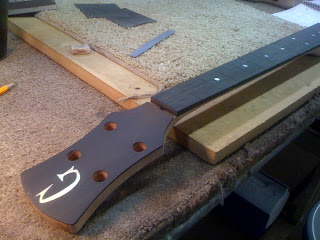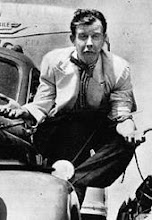Well dang, what a weekend!
Finally made it to a
NAMM show and what a spectacle it was. NAMM is held annually at the Anaheim Convention Center in LA. It runs for 4 days and comprises virtually all of the mid to major level music merchants in the US. There are so many exhibits you can walk around for 4 days and not see everything. Unbelievable in size and scope, tons of new products available and the people watching was insane. Aside from trying to take in all the musical gear, I saw many a celebrity rocker (and some not so much), met Duane Eddy, Kedzie Matthews & Slash, hobnobbed with some of the guitar world's cognoscenti and finally made it to one of
Deke Dickerson's Guitar Geek Festivals. A solid weekend! Some highlights:
Outside the convention center:
A wall of Fender's new La Carbonita model: (a super simple Telecaster style guitar with one TV Jones/Gretsch pickup model built in the Custom Shop... so it's mega expensive, around $5K.) You gotta hand it to Fender for knowing how to make money. Granted, these look like pretty sweet machines.
Tele man
Jim Campilongo shows off his new signature model: a copy of his '59 top loader. A feather light instrument! Wish I had actually heard him play it:
Across the way at the Gretsch booth, the new Eddie Cochran 6120 model was in glass along with a host of goodies that come with uber collectible guitar:
Bob Brozman was hanging out and noodling at the
National Reso-Phonic booth. He's an amazing musician, entertainer and ethnomusicologist. He literally wrote the book on the history of the National resonator guitar. He'd start a tune on a Style 1 roundneck:
and mid-song would switch to a square neck without missing a beat. Amazing:
Adam West's Batmobile was at the Hallmark booth!
Hallmark/Batmobile Guitar Hero controller:
Below, Martin's new bartione acoustic. I have a soft spot for baritone guitars. Martin's sounded beautiful! Note the side port:
Gross: double neck acoustic Flying V with 12/6 string necks. So staggering was this tasteless feat of idiocy that I failed to notice the acoustic Explorer to the left:
Dean Zelinksky is known for building pointy, hair-band-style guitars. He had a cool new design at the show though, a sort of Gibson ES-335 style electric. The edges of the guitar were tapered down to a super thin 1/4 inch or so, thickening up in the center of the body where the pickups and hardware were mounted. Kinda like one of a single pack Advil: skinny on the edges with a plump center, if you follow.
Zelinsky knows how to make a splash. Check out the real attention grabber at his booth:
More novelty time: triangle shaped guitar speaker cabinets?
Pretty cool looking I guess. Problem is, what if you want just one? Do you just lean the head on the side of it or something? Sheesh...
Onwards then to Stevie Vai frozen in carbonite:
Silly.
Celebrity highlight #1: My pal, Tommy Rockstar, who is an old friend of Mr Brownstone, waited on line with me to meet Slash. I credit Slash with getting me started on the guitar. The first song I learned to play was "Don't Cry" by Guns n' Roses. I was thirteen and it changed everything! Pretty cool to finally meet the guy. Tommy was even more exited though. He had Slash autograph his arm:
...and then promptly had the autograph tattooed!!
wow... that's some real GnR love.
So then I was off to Deke's 7th Annual Guitar Geek Festival:
I couldn't possibly document the whole thing but if you're interested, check out Tim aka Proteus' coverage
here at the Gretsch Pages. I'll just include a couple cool shots. Below is the crude home made double neck lap steel that Speedy West played before getting his Bigsby steel guitar... talk about moving on up! The sign says "do not touch." I touched... I had to! Sorry, Deke.
Terry N. McArthur built Deke's iconic double neck guitar in 1958 when he was just seventeen. With some help from none other than Semie Moseley, Terry went about copying the guitars played by his idols, Joe Maphis and Larry Collins. Terry recently got back into guitar building after retiring from a career as a cabinet builder. Here are a few of his wonderfully over the top instruments:
Terry playing a guitar made by Larry Collins in the '50s:
Another highlight from Deke's guitar museum, Scotty Moore's Echosonic amp! This was the amp that was there to record Elvis' early hits on Sun Records. WOW!!! It has a built in tape delay, THE requisite sound effect for rockabilly tone. Chet Atkins also used one of these amplifiers to record his hit version of,
"Mr Sandman." Leave it to Deke to come into possession of this historic piece of music history.

Saving the best for last, I was lucky enough to chat with Mr TONE, Duane Eddy for a couple minutes. The fella got up and played an incredible set of his instrumental hits. It was jaw dropping. Duane Eddy:
Twang's the Thang! ~House of Twang~ itself is named as a tip of the cap to Duane. It was truly one of the great guitar extravaganzas that I've ever witnessed. Good to see him back playing a
Gretsch 6120 DSV... and you wonder why I'm so obsessed by these guitars. He was plugged into a couple early '60s Fender Dual Showman amps. (Guitar Geek side note: Tim/Proteus, who covered the Deke show as well as the Gretsch booth at NAMM, has a side business crafting replacement bridges for the modern Gretsch fleet. His "Tru-Arc" bridges accurately match the fingerboard radius of the various models currently made by Gretsch. Until now, some of the Gretsch guitars suffered from minor intonation issues since they were outfitted with a standard radius bridge that may or may not have matched the fingerboard radius. The Tru-Arc solves these tuning problems as they are available in a variety of radii depending on the model at hand. The Tru-Arc has been getting rave reviews but has yet to have a celebrity endorsement, until now: Duane had one outfitted on his 6120 that night! What more convincing could you need? Sold! Congrats to Tim for reaching milestone. Exhaustive coverage of Duane's set
here.)
Duane Eddy, his Gretsch and me:
Deke backing up Duane:
After all that, you'd think I'd be done with my guitar geeking a good while.
Fear not, readers!
Much more to come...

























































